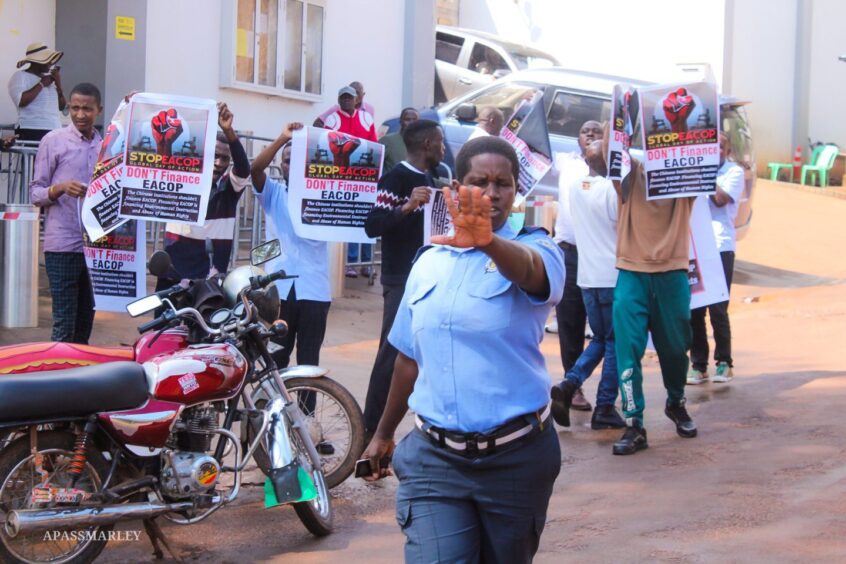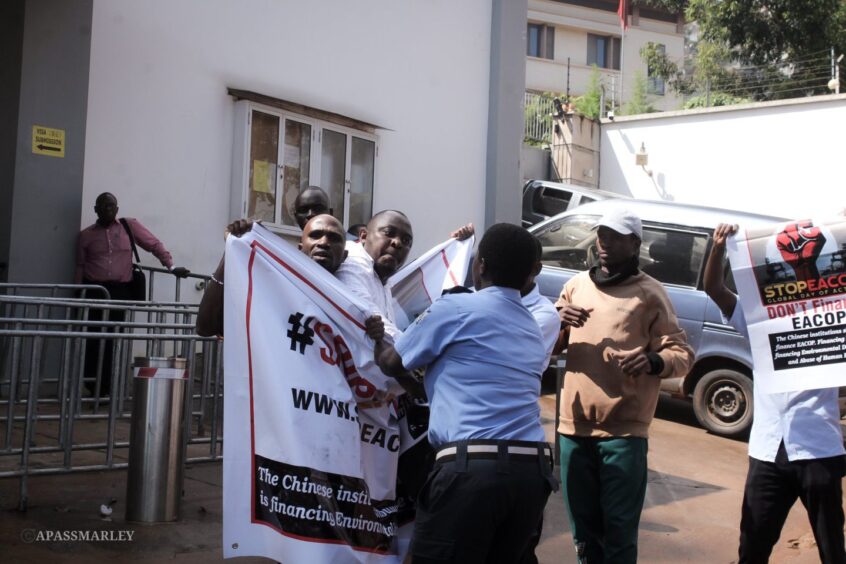
Uganda has published new details of safety features on the East African Crude Oil Pipeline (EACOP), even as demonstrators around the world protest the plan.
Demonstrators have declared today a “global day of action” to stop EACOP, which will run from west Uganda to a port in Tanzania. The project will cost around $4 billion and will be the longest heated pipeline in the world.
Protests called for Sinosure, the Chinese export credit agency, to back away from its pledges of insuring the pipeline. Uganda has seen Sinosure’s presence as crucial in delivering the pipeline plan.
The StopEACOP group also noted the presence of China’s Eximbank and ICBC in supporting the plan.
“It is critical that we seize this moment, during which deliberations are ongoing, to call on these institutions, and the Chinese state, to make the right decision and decline support” for EACOP, it said.
Protests were due to take place in Washington DC, Kampala, Dar es Salaam, Kinshasa, Tswhane, Paris and London.
According to AIFE Uganda, police in Kampala arrested seven StopEACOP activists this morning. A number of local NGOs called for the police to release them.
Complaints against EACOP have primarily focused on the relocation of people along the pipeline route and the environmental impact.
Earlier this month, GreenFaith reported that EACOP had also “on numerous occasions, disturbed or disrespected the graves” of locals and ancestors.
EACOP “categorically” denied the report. GreenFaith’s report, on graves and around the displacement of people, “were not subject to elementary fact-checking”.
Satellite monitoring
Against this contested background, the Petroleum Authority of Uganda (PAU) today published more plans about EACOP’s construction. The 1,443 km line would have a sophisticated monitoring system, it said, to be able to respond in seconds to any pressure changes. A change in pressure might suggest a leak or sabotage.
“With its extensive fibre-optic network allowing online connectivity, EACOP promises to be one of the world’s smartest and safest bulk pipelines with real-time monitoring along its entire length via satellite,” said Dozith Abeinomugisha, director in-charge of midstream developments at the PAU.
The PAU EACOP company would have real-time monitoring centres, receiving updates via satellite.
The Ugandan section will be carbon neutral, using 80 MW of solar and hydropower, it said. Work is under way on the longer Tanzanian section.
The pipeline must be heated to at least 50 degrees Celsius in order to keep the oil flowing. The plan is to keep it at 80 degrees, with two heating stations, in order to keep the fluid moving. The pipeline will use Long Line Heat Tracing (LLHT) to keep the temperatures consistent.
In order to build the pipelines to the correct specifications, the company is building a coating factory in Tanzania. This will ensure that each 18 metre section of pipe has the right layering.
Growth plans
Tilenga and Kingfisher, the two fields, will reach peak production of 230,000 barrels per day. EACOP will have capacity of 246,000 bpd, to allow for potential additional discoveries and the planned refinery’s needs.
“Uganda can be proud of its place at the cutting edge of pipeline technology with EACOP showing how committed the country is to develop its oil and gas assets responsibly, openly and profitably. Uganda will not only benefit through earnings from the sale of crude oil, but from the engineering and technical skills transfer driven by the EACOP project,” said Abeinomugisha.
The first 100 km of pipe sections have been manufactured in China and are expected to arrive at Dar es Salaam within weeks. The PAU went on to say it expected EACOP would lay the first sections around mid-2024.

 © Supplied by AIFE Uganda
© Supplied by AIFE Uganda